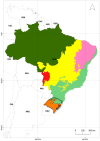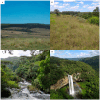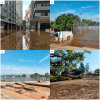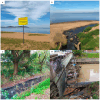Environmental Challenges in Southern Brazil: Impacts of Pollution and Extreme Weather Events on Biodiversity and Human Health
- PMID: 40003530
- PMCID: PMC11855841
- DOI: 10.3390/ijerph22020305
Environmental Challenges in Southern Brazil: Impacts of Pollution and Extreme Weather Events on Biodiversity and Human Health
Abstract
The Amazon rainforest plays a fundamental role in regulating the global climate and therefore receives special attention when Brazilian environmental issues gain prominence on the global stage. However, other Brazilian biomes, such as the Pampa and the Atlantic Forest in southern Brazil, have been facing significant environmental challenges, either independently or under the influence of ecological changes observed in the Amazon region. The state of Rio Grande do Sul is located in the extreme south of Brazil and in 2024 was hit by major rainfalls that caused devastating floods. The Pampa is a non-forest biome found in Brazil only in Rio Grande do Sul. This biome is seriously threatened by loss of vegetation cover and many classes of pollutants, including pesticides and plastics. Mining ventures are also important sources of soil, water and air pollution by potentially toxic elements in Rio Grande do Sul, threatening both the Pampa and the Atlantic Forest. Furthermore, southern Brazil is often affected by pollution caused by smoke coming from fires observed in distant biomes such as the Pantanal and the Amazon. Considering the significant environmental challenges observed in southern Brazil, this article revisits the historical participation of Rio Grande do Sul in Brazilian environmentalism and highlights the main environmental challenges currently observed in the state, followed by an in-depth analysis of the effects of pollution and extreme weather events on biodiversity and human health in the region. This review encompassed specifically the following categories of pollutants: potentially toxic elements (e.g., arsenic, cadmium, chromium, cobalt, copper, lead, mercury, titanium), air pollutants, plastics, and pesticides. Pathogen-related pollution in the context of extreme weather events is also addressed. This article emphasizes the critical importance of often-overlooked biomes in Brazilian conservation efforts, such as the Pampa biome, while also underscoring the interconnectedness of climate change, pollution, their shared influence on human well-being and ecological balance, using Rio Grande do Sul as a case study.
Keywords: Brazil; Rio Grande do Sul; biodiversity; climate change; extreme weather events; particulate matter; pesticide; plastics; pollution; potentially toxic elements.
Conflict of interest statement
The authors declare no conflicts of interest.
Figures








Similar articles
-
The impact of wildfires on air pollution and health across land use categories in Brazil over a 16-year period.Environ Res. 2023 May 1;224:115522. doi: 10.1016/j.envres.2023.115522. Epub 2023 Feb 20. Environ Res. 2023. PMID: 36813066
-
Remote sensing environmental indicators for monitoring spatial and temporal dynamics of weather and vegetation conditions: applications for Brazilian biomes.Environ Monit Assess. 2023 Jul 12;195(8):944. doi: 10.1007/s10661-023-11560-8. Environ Monit Assess. 2023. PMID: 37438658
-
Ant diversity (Hymenoptera: Formicidae) in Turvo State Park, municipality of Derrubadas, state of Rio Grande do Sul, Brazil.Braz J Biol. 2021 Jun 14;83:e239642. doi: 10.1590/1519-6984.239642. eCollection 2021. Braz J Biol. 2021. PMID: 34133487
-
The 2023 Latin America report of the Lancet Countdown on health and climate change: the imperative for health-centred climate-resilient development.Lancet Reg Health Am. 2024 Apr 23;33:100746. doi: 10.1016/j.lana.2024.100746. eCollection 2024 May. Lancet Reg Health Am. 2024. PMID: 38800647 Free PMC article. Review.
-
Effects of air pollution on ecosystems and biological diversity in the eastern United States.Ann N Y Acad Sci. 2009 Apr;1162:99-135. doi: 10.1111/j.1749-6632.2009.04153.x. Ann N Y Acad Sci. 2009. PMID: 19432647 Review.
References
-
- Cordeiro J.L., Hasenack H. Cobertura vegetal atual do Rio Grande do Sul. In: Pillar V.P., Müller S.C., Castilhos Z.M.S., Jacques A.V.A., editors. Campos Sulinos—Conservação e Uso Sustentável da Biodiversidade. Ministério do Meio Ambiente; Brasília, Brazil: 2009. pp. 285–299.
-
- Tomazelli L.J., Villwock J.A. O Cenozóico costeiro do Rio grande do Sul. In: Holz M., De Ros L.F., editors. Geologia do Rio Grande do Sul. Edição CIGO/UFRGS; Porto Alegre, Brazil: 2000. [(accessed on 27 September 2024)]. pp. 375–406. Available online: https://www.ufrgs.br/estratigrafia/Diversos/Tomazelli%20&%20Villwock%202....
-
- Reginato P.A.R., Ahlert S. Geologia: Formação geológica da planície das lagoas costeiras. In: Schäfer A., Lanzer R., Scur L., editors. Atlas Socioambiental dos Municípios de Cidreira, Balneário Pinhal, Palmares do Sul. Educs; Caxias do Sul, Brazil: 2013. p. 193.
-
- Echer R., da Cruz J.A.W., Estrela C.C., Moreira M., Gravato F. Usos da terra e ameaças para a conservação da biodiversidade no bioma Pampa, Rio Grande do Sul. Rev. Thema. 2015;12:4–13. doi: 10.15536/thema.12.2015.4-13.318. - DOI
-
- Külkamp J., Heiden G., Iganci J.R.V. Endemic plants from the Southern Brazilian Highland Grasslands. Rodriguésia. 2018;69:429–440. doi: 10.1590/2175-7860201869214. - DOI
Publication types
MeSH terms
Grants and funding
LinkOut - more resources
Full Text Sources

